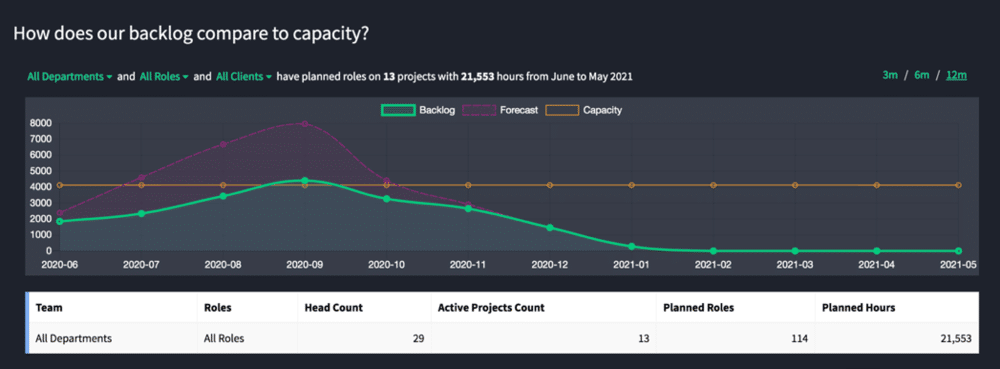How Digital Services Succeed: Revenue Targets
This situation is all-too-common: An agency owner sets revenue targets based on the previous year’s results with the assumption that they should do even better this year. They set these targets and hope for the best.
But let’s be clear, hope is not a plan. The revenue targets that were meant to be aspirational become points of contention when leadership and employees don’t know how they’re going to meet them
To hit revenue targets, organizations need a business development strategy and data to track how they’re performing. This requires them to proactively monitor leading indicators of revenue, adopt best practices for tracking against these targets, and compare their performance to industry benchmarks.
In this post, we break down how business owners—with the support of their teams—can start tracking revenue targets effectively right now.
Table of Contents
- Why Tracking Revenue Targets Is Important for Strategic Growth
- How to Measure Revenue Proactively
- Best Practices for Tracking Revenue Targets
This guide is the third part in a series all about best practices for professional services sales and operations. Our first and second posts provide recommendations for measuring and using utilization and project margin metrics. Be sure to check out Part One and Part Two so you don’t miss a thing.

Why Tracking Revenue Targets Is Important for Strategic Growth
Agencies that use their sales pipeline to forecast revenue can proactively take action to generate new business before they miss revenue targets. Visibility into and regular assessment of the sales pipeline enables teams to respond accordingly when there’s a predicted shortfall in incoming work.
Responding to dips in the sales pipeline, instead of workload dips, stabilizes revenue and increases the likelihood that the business will meet its goals.
Let’s consider a hypothetical agency that made $1 million in revenue last year. This year, the owner decided to aim for a revenue target of $1.5 million. If they want to hit that goal, they need a plan for how they’re going to do it.
Keeping calendar considerations in mind, they know the first and fourth quarters will naturally have less revenue due to seasonality. Using these distributions as a starting point, they set targets for each quarter.
Throughout the year, the agency uses data from its sales pipeline to measure the leading indicators of revenue that help the business understand if it’s on track to meet its quarterly revenue targets. If they don’t have enough in their pipeline to hit their revenue target, it’s a signal to step up business development efforts to generate new opportunities.
If they fill these dips proactively, they can avoid a slow period of work with low utilization.
Creating a Shared Perspective to Motivate Employees
Agency owners don’t have to shoulder the pressure of filling sales pipeline dips alone. They hired smart solution engineers, team leads, and project managers that interface with customers regularly.
By arming these employees with the right information and context, they can help the owner identify additional revenue opportunities. Communicating transparently with these employees about revenue targets also builds trust and motivates them.
Leaders might hesitate to share revenue metrics with employees because they don’t want to put undue pressure on them or cause stress if the business isn’t doing well. But when owners empower customer-facing employees with the right information, the default mode of employees is to step up and support the agency’s success in whatever way possible.
Let’s take a look at the metrics and the best practices for tracking revenue we recommend all digital agencies share with employees.
How to Measure Revenue Proactively
Digital agencies can stay on top of revenue targets by tracking the following metrics.
Deal Pipeline Compared to Quarterly Bookings Target
Compare the projected amount of revenue in the sales pipeline to quarterly booking targets. This helps the team identify how many new sales opportunities they need to generate to hit revenue targets. Benchmarks suggest that the sales pipeline should have at least double what the sales target is in qualified opportunities.

Percentage of Quarterly Revenue Target in the Backlog
Track what percentage of your quarterly revenue target is already sold and in the backlog for the quarter. Agencies should aim to have at least 50% of the revenue planned out before the quarter begins.

Revenue Capacity Compared to Target
Track your revenue capacity and compare it to your target to understand your actual ability to earn revenue based on resource mix, utilization expectations, earned bill rates, and more.
For example, if all employees work what the agency expects them to work in hours, you should know what the agency can make. If you have a lower utilization than anticipated, this impacts the agency’s earning capacity.

We adapted these benchmarks from SPI’s PS Maturity Model™, which helps organizations use benchmarking to improve their profitability, performance, and growth. We subscribe to and respect this industry-standard model, and recommend all professional service organizations reference it.
Best Practices for Tracking Revenue Targets
To effectively track and meet revenue targets, you should follow these best practices:
- Standardized service offerings: Instead of approaching each project as custom and new, develop a consistent and repeatable process to sell, market, project manage, and deliver each of your service offerings. This creates efficiency, cost savings, and makes it easier to plan for projects. It also makes it easier to project revenue. We’ll dive deeper into how to do this in future posts.
- Resourcing deal pipeline tracking: Don’t wait until you sell a project to start putting resources against it. Resource against the entire sales pipeline. This will feed your forecasts with valuable information that will help you make proactive decisions about whether you need to hire for certain roles. Then, once the work begins, you have the team in place that can start delivering on it.
- Collaborative and consistent pricing: When your team sells and prices services consistently, planning and forecasting are more effective. A measured and consistent approach to pricing makes reviewing progress toward revenue goals easier.

Stabilize Revenue With Sales Pipeline Data
A healthy sales pipeline that receives regular attention is the key to stabilizing revenue. Agencies that give their employees visibility into sales data are in a better position to adopt the habits necessary to proactively fill would-be revenue dips.
Parallax has been helping numerous digital agencies understand and implement these best practices. The product reinforces data governance habits and creates a shared perspective across teams.
If you’d like to learn how Parallax can help you develop these habits and empower your team with the insights needed to inform strategic planning, reach out to us to schedule a demo.


